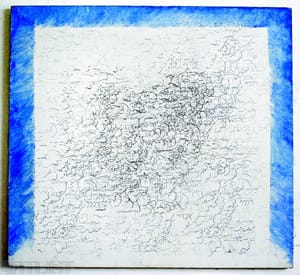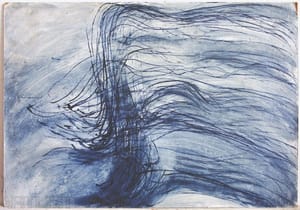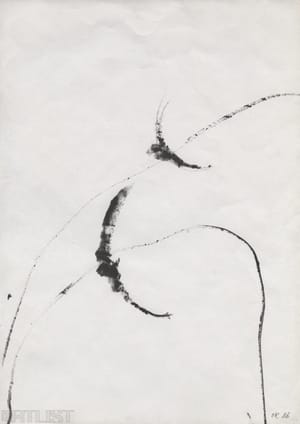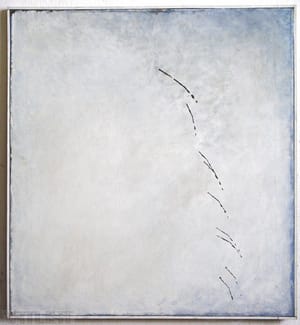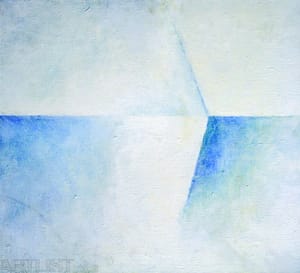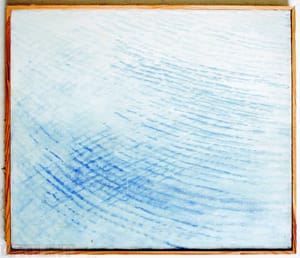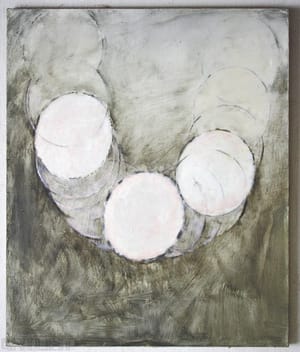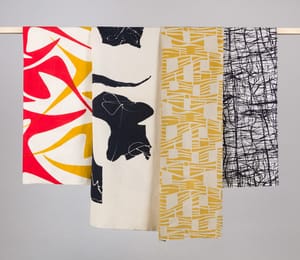- First Name
- Olga
- Surname
- Karlíková
- Born
- 1923
- Birth place
- Praha
- Died
- 2004
- CSU Library
- ↳ Find in the catalogue
About artist
During the war Olga Karlíková studied at the Officina Pragensis design school, after which until 1948 she attended the Academy of Arts, Architecture and Design in Prague at the ateliers led by A. Strnadel and A. Kybal. As well as free work she created designer textiles for ÚBOK (the Institute of Residential and Clothing Culture), an institution for which many other artists worked. At a time when it was impossible to exhibit abstract art, this design work allowed her to work with abstraction, as can be seen in the Czech contribution to the World Exhibition EXPO 58. Karlíková lived and worked in Prague, and from the middle of the sixties worked in ateliers in Northern Bohemia.
Olga Karlíková is a member of the generation which during the sixties completed its entry into the wider international context, only to experience repressive normalisation after the August occupation in 1968. At first her work was inspired by the circle surrounding Václav Bartovský, in whose atelier she encountered artists who in the fifties formed the UB 12 group, an offshoot of the Umělecká beseda group, V. Boštík, S. Kolíbal, A. Šimotová, J. John, Věra and Vladimír Janoušek, and many others. (A critic and theoretician close to them in opinion was Jindřich Chalupecký, whom she met through Bartovský). However, Olga Karlíková was also interested by structural abstraction and art informel, which allowed her to commence an examination of her life-long themes of space, land and sea, later joined by the song of birds, whales and recordings of their movement. Her early work with the structure of colour transformed symbols of land or water and opened them up to an endless space, which became her dominant theme. However, this space had a deceptive form – in pictures of friends’ ateliers, chapels, houses in Segurette, as well as in pictures of the sea, which the artist encountered in France in the middle of the sixties. In these pictures space is multiplied by light and its reflections, creating subtle abstract constructions. Her pictures of the sea, space and light represent the search for a pictorial expression and the symbolisation thereof, similarly to Václav Boštík who linked symbols of the cosmos and its sacral foundation in his pictures.
During the sixties Olga Karlíková’s work turns to the acoustics of natural space, to details of its intangible infinity, represented in her work by the song of birds or whales, the croaking of frogs, as well as the sounds of bells or drums. She recorded these in drawings using pencil, brush and ink or pen, and her records have a scriptural character. Sometimes she captured the songs of birds and sounds of nature by means similar to seismographic recordings of the course and intensity of sound on a gradually revolving role of paper. However, she transferred these recordings into pictorial form, though these recordings retained their scriptural character in colour surfaces defining the space. The recordings of natural sounds, voices, tones or song unfold with the movement of their originators, with swifts, humming birds, rooks, larks within the space of their existence. However, space and time and the course of movement were not abstract categories for Karlíková, they interpreted the artist’s perception of their permanence and infinity while operating as a profound experience generalised into spiritual form. The polarity of intimate, searching and listening sensitivity was balanced by a knowledge of the general order and its eternality. Her perception and interpretation of the appearance of nature can be understood as being close in a certain way to Chinese poetry and Taoist meditations on natural phenomena, which she was well acquainted with. If you understand the heart of these two plants / then you can measure the surf of the sea, writes a Chinese poet.
In this way the work of Olga Karlíková can be understood as a score or notation. However, her recordings of natural sounds are not bound by the five-line stave, but spread out in the form of a mobile recording of sounds into space. In the sixties John Cage and his pupils were involved with sound recordings and notations at Black Mountain College. At the end of the fifties Edgar Varése created a score of his audio construction Poéme électronique for Corbusiér’s pavilion at Expo 58, and in the sixties Milan Grygar created his performative acoustic drawings. The work of Olga Karlíková represents, in the structural pictorial forms of earth and water, a spontaneous analogy to land art, while at the same time the transformation of natural acoustic phenomena anticipated conceptualism, a fact borne out by her participation in 1993 at the exhibition of conceptual art by M. Palla, M. Šejn and M. Maur.
After 1977, when she signed Charta 77, her work was completely removed from public space. However, it was presented during the eighties at an extensive exhibition prepared by Ludvík Hlaváček in the cloister at Doksany. Her inputs into the intimacy of natural appearance and its significance were perceived at that time as an ethical gesture.
- Author of the annotation
- Jan Rous
- Published
- 2010
CV
1941-1943 Academy of Arts, Architecture and Design, Prague, Antonína Strnadela´s studio
1945-1948 Antonín Kybal´s studio
1939-1940 Graphic School of J. Šváb
Exhibitions
- Solo exhibitions
-
2012
Olga Karlíková: Slyšené krajiny, Galerie Vysoké školy uměleckoprůmyslové (Galerie VŠUP), Praha 1 (Prague)
2011-2012
Olga Karlíková: Byl večer a bylo jitro, den pátý, Galerie Benedikta Rejta, Louny
2010
Prostor pro světlo a řeč přírody, Topičův salon, Praha (Prague)
Olga Karlíková: Svišťouni, žáby a skřivani, Galerie Školská 28, Praha
2005
Galerie Atrium Praha
2000
Galerie umění Karlovy Vary
1999
Obecní galerie Beseda Praha
1998
Galerie Jiřího Jílka Šumperk, Galerie Klenová Klatovy
1997
Městské museum a galerie Synagoga Hranice, Stëdtische Galerie Wolfsburg
1996
Galerie výtvarného umění Litoměřice, Výstavní síň Emila Filly Ústí n.L.
1995
Galerie Via Art
1993
České muzeum výtvarných umění Praha /s M. Pallou, M. Šejnem a M. Maurem/
1990
Galerie moderního umění Roudnice n.L.
1988
Ústav makromolekulární chemie Praha
1987
Sovinec
1983
Klášter Doksany a Nemocnice Vysoké Mýto
1975
Galerie ve věži Mělník /se S. Klimešem/
1964
Umělecká beseda,
1959
Galerie ČS Praha
- Group exhibitions not included in ARTLIST.
-
2013
Doteky hudby, Severočeská galerie výtvarného umění v Litoměřicích, Litoměřice
Výtvarné umění - výstava, Galerie Nová síň, Praha (Prague)
2009-2010
Vizuální poezie, Geofyzikální ústav AV ČR, přednáškový sál, Praha (Prague)
2008
Pohledy do sbírek Severočeské galerie výtvarného umění v Litoměřicích, Severočeská galerie výtvarného umění v Litoměřicích, Litoměřice
2007
Die durchsichtige Welt, Landschloss Pirna - Zuschendorf, Pirna - Zuschendorf
Průzračný svět: Podoby vody / Durchsichtige Welt, Galerie moderního umění v Roudnici nad Labem, Roudnice nad Labem
2005
Místa paměti, Galerie Šternberk, Šternberk
Prostor a čas, Galerie moderního umění v Roudnici nad Labem, Roudnice nad Labem
..o věcech přírodních, Letohrádek Ostrov, Ostrov
2004
Šedesátá / The sixties ze sbírky Galerie Zlatá husa v Praze, Dům umění města Brna, Brno
Showtime: A Century of the Czech Film Posters, Museu de Arte de Macau / Macao Museum of Art, Macao
Za sklem. Ze sbírky Jaroslava Krbůška, Galerie Jiřího Jílka, Šumperk
Hudba ve výtvarném umění, Kolín, Kolín
Sterne und Illusionen: Tschechisches Filmplakat des 20. Jahrhundert, Tschechisches Zentrum Dresden (České centrum Drážďany), Drážďany (Dresden)
2003-2004
Umění je abstrakce. Česká vizuální kultura 60. let, Salon, Kabinet, Olomouc
2003
World of Stars and Illusions: Gems of the Czech Film Poster Tradition, Czech Centre New York (České centrum New York), New York
Svět hvězd a iluzí. Český filmový plakát 20. století, Mánes, Praha
2002
Možná sdělení, Moravské uměleckoprůmyslové muzeum, Brno
Minisalon, Majapahit Mandarin Hotel, Surabaya
2001-2002
Pour félicité 1972 - 2002: Adresát MUDr. Jaroslav Dostál, Galerie Jiřího Jílka, Šumperk
2001
Možnosti proměny I, Galerie Františka Drtikola, Příbram
2000
Moderní česká kresba, Galerie Vltavín, Masarykovo nábřeží, Praha
Současná minulost. Česká postmoderní moderna 1960-2000, Alšova jihočeská galerie v Hluboké nad Vltavou, Hluboká nad Vltavou
1999
Přírůstky sbírek státních galerií z let 1990-1997, Jízdárna Pražského hradu, Praha (Prague)
Umění pro nemocnici, Galerie Václava Špály, Praha (Prague)
1998-1999
Umělecká beseda 1998, Mánes, Praha (Prague)
1998
Minisalon, Bibliotheque Royal de Belgique, Brusel (Bruxelles)
1997-1998
Proměny krajiny v českém malířství 20. století, Veletržní palác, Praha
1997
Umělecká beseda, Galerie Bayer & Bayer, Mostecká 16, Praha
Umění zastaveného času / Art when time stood still, Česká výtvarná scéna 1969-1985, Státní galerie výtvarného umění v Chebu, Cheb
Z nesbírky Marcely Pánkové, Galerie Hermit - Studio 600, Praha
1996
Temple Bar International Prints, Temple Bar, Dublin
1991- 1995
Umělecká beseda, Výstavní síň Mánes Praha
1995
Umění frotáže / Art of Frottage, Galerie výtvarného umění Litoměřice, Oblastní galerie Liberec, Muzeum Kroměříž
1994
Záznam nejrozmanitějších faktorů / Records of the most various factors, Jízdárna Pražského hradu, Praha
Ohniska znovuzrození / Focal Points of Revival, Galerie hlavního města Prahy – městská knihovna Praha
1992
Přírůstky Národní galerie / Acquzitions of the National Gallery in Prague, Jízdárna Pražského hradu, Praha
Tvary tónů / Forms of Tones, Výstavní síň Mánes
1991
Kontrasty / Contrasts, Dom kultúry Bratislava
V dimenzích prázdna / In Dimensions of Void, Galerie moderního umění Roudnice nad Labem
Šedá cihla / Grey Brick, Galerie U bílého jednorožce Klatovy, Dům umění Opava
1990
Kontrasty / Contrasts, Výstavní síň ÚLUV Praha
Cesty kresby a grafiky / Ways of drawings and graphics, Palác kultury Praha
1989
Pocta umělců J. Chalupeckému / Honor of artists to Jindřich Chalupecký , Městská knihovna, Praha
1988
Miedzinarodowe trienale risunku Wroclaw / International Triennale of drawings, Polsko
1977
Poéticas visuasis / , Museu de arte contemporanea Sao Paulo, Brazílie
1969
L´art tchéque actuel, Renaault-Elyssées Paríž, Francie
1967
Galerij Orez Haag, Holandsko
1966
Jarní výstava 66 / Spring Exhibition 66, Výstavní síň Mánes, Praha
1964
Rychnov 64, Orlická galerie Rychnov nad Kněžnou
1963
Sto let Umělecké besedy / 100 years of Umělecká beseda, Obecní dům Praha
1964
Výstava mladých / Exhibition of Youngs, Dům umění Brno
- Collections
- National Gallery, Prague, Moravian Gallery, Brno, Art Gallery, Karlovy Vary, Klenová/Klatovy Gallery, North Bohemian Gallery of Fine Arts, Litoměřice, Benedikta Rejt´s Gallery, Louny, Gallery of Fine Art, Ostrava, East Bohemian Gallery, Pardubice, Czech Museum of Fine Art, Prague, Zlatá husa Gallery, Prague, Gallery of Modern Art, Roudnice n.L., Columbia University, New York (USA)
Monography
- Monography
(selection)
Všeobecná encyklopedie ve čtyřech svazcích Diderot, díl II
Dějiny českého výtvarného umění VI/I, II, Academia, Praha 2007
L. Vachtová, Obrazy Olgy Karlíkové, Host do domu 8/1964
L. Vachtová, Země Olgy Karlíkové, VU 8/1969,
M. Hlaváčková, text v katalogu výstavy v Roudnici n.L. 1990
J. Valoch, O.K. text katalogu výstavy v Roudnici n.L. 1990
J. Valoch, O.K. text katalogu výstavy v Litoměřicích 1996
J. Valoch, Reflexe některých přírodních fenomenů, text kat. výstavy v Hranicích 1997
M. Nešlehová, Poselství jiného výrazu, Praha 1997
V. Cílek, Dýchat s ptáky, Dokořán, Praha 2009
M. Vojtěchovský, Olga Karlíková, svišťovi, žáby a skřivani, taxt k výstavě Galerie Školská 28 2010
J. Rous, O.K. Prostor pro světlo a řeč přírody, text katalogu k výstavě v Topičově salonu 2010
